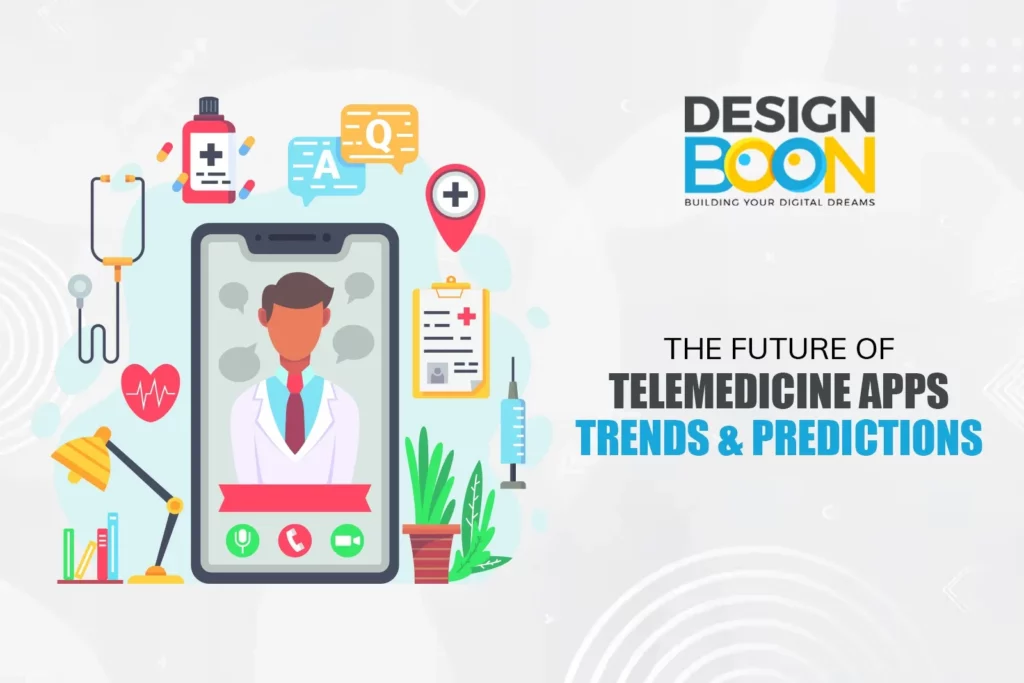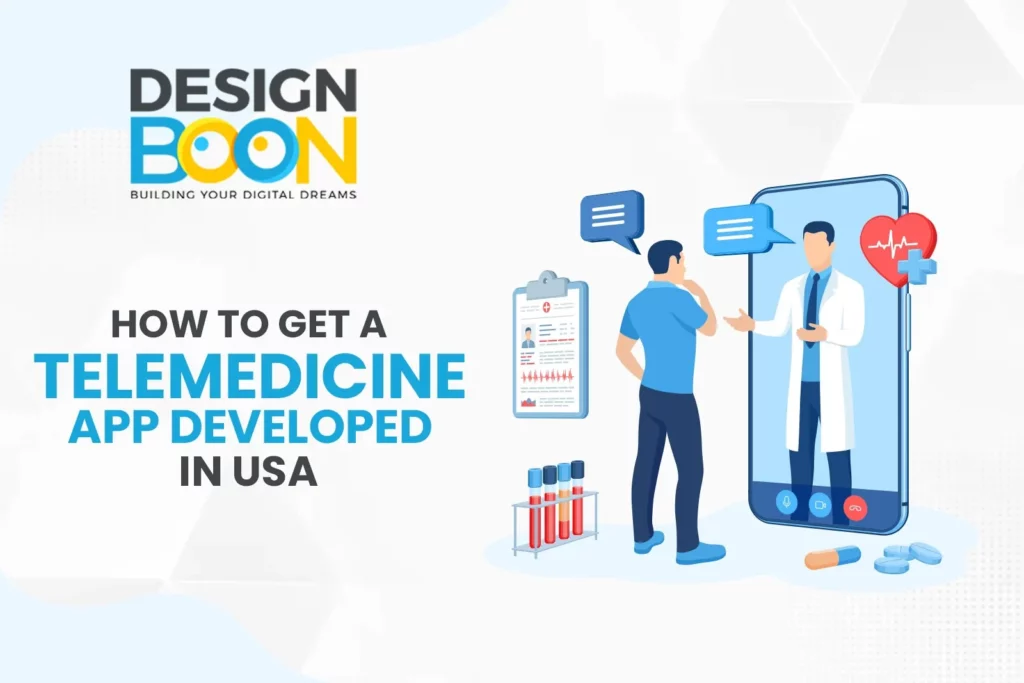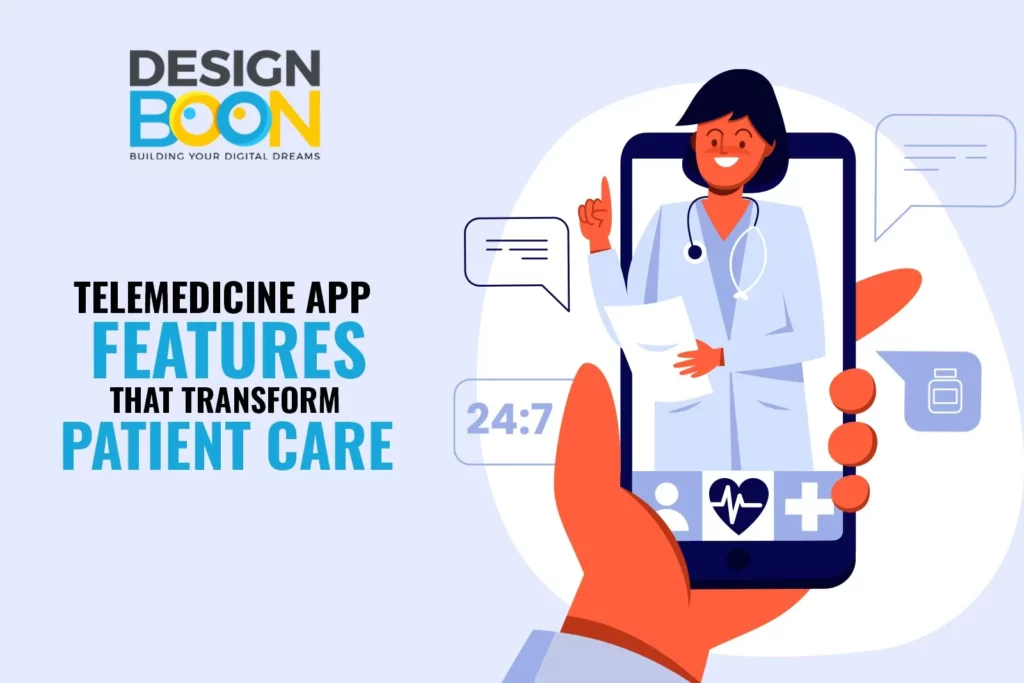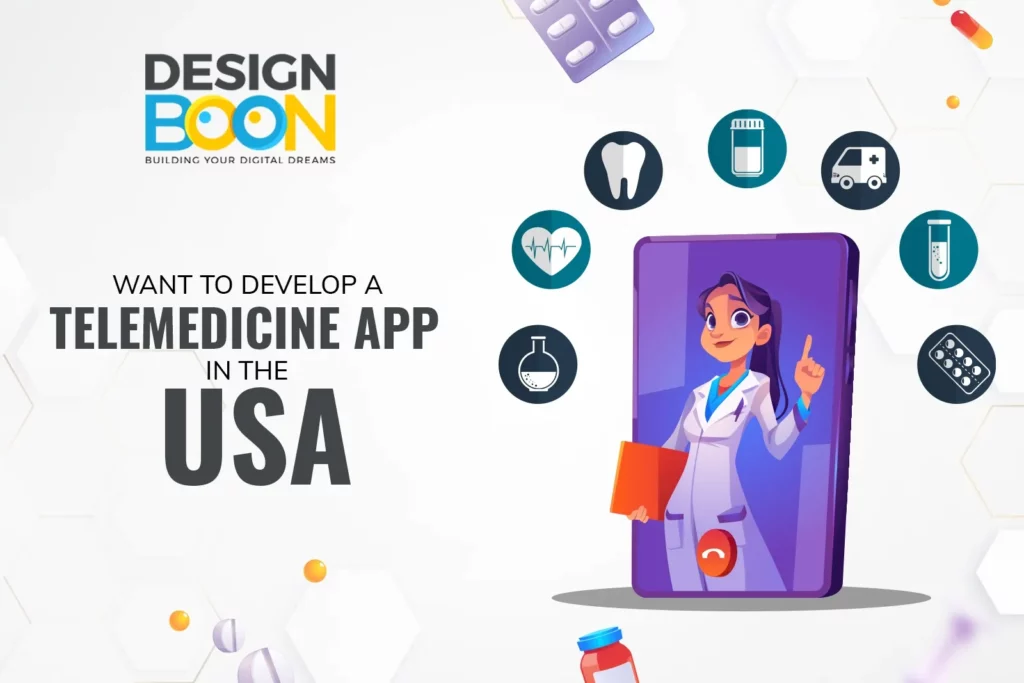Telemedicine is a game-changer in the healthcare industry. It allows patients and providers to connect remotely, using technology to deliver quality care. Telemedicine has evolved significantly in the USA, from its humble beginnings as a way to reach rural areas to its current status as a mainstream healthcare service. According to a report by Grand View Research, the US telemedicine market size is expected to grow at a compound annual growth rate (CAGR) of 19.2% till
In this blog post we will be unveiling the intricate details of the latest trends and future predictions for telemedicine apps and how you can get one developed for your business needs. You’ll gain insights into the pivotal steps and crucial considerations when embarking on the development of a telemedicine app. We’ll explore the transformative power of essential features that elevate patient care to new heights. And, to crown it all, we’ll unveil the beacon of excellence — the best telemedicine app development company in the USA. So lets start with
The Future of Telemedicine Apps: Trends and Predictions

Telemedicine apps are applications that allow patients and providers to communicate and access health services remotely, using devices such as smartphones, tablets, or computers. Telemedicine apps can offer various benefits, such as convenience, accessibility, safety, and cost-effectiveness, especially during times of crisis like the COVID-19 pandemic.
Telemedicine apps are not a new concept, but they have gained significant popularity and adoption in recent years, thanks to the advancement of technology and the changing needs and preferences of consumers and clinicians. According to a report by McKinsey, telemedicine app usage is 38 times higher than before the COVID-19 pandemic, and 80% of consumers have used a telemedicine app at least once.
The factors driving this growth include the increasing demand for virtual care, the rising prevalence of chronic diseases, the aging population, the government initiatives and policies, and the innovation and investment in digital health solutions.
Some of the current trends and predictions for the future of telemedicine apps are:
- Increased integration and interoperability: Telemedicine apps will need to integrate and interoperate with other health information systems, such as electronic health records (EHRs), personal health records (PHRs), health information exchanges (HIEs), and wearable devices, to ensure seamless data sharing and coordination of care.
- Expanded scope and diversity of services: Telemedicine apps will offer a wider range of services, such as primary care, specialty care, mental health, wellness, prevention, chronic disease management, and home health care, to cater to the diverse needs and preferences of consumers and clinicians.
- Improved quality and outcomes: Telemedicine apps will leverage artificial intelligence (AI), big data, and analytics to enhance the quality and outcomes of care, such as diagnosis, treatment, monitoring, and follow-up. Telemedicine apps will also use evidence-based guidelines, clinical decision support, and quality indicators to ensure adherence to best practices and standards.
- Enhanced user experience and satisfaction: Telemedicine apps will focus on improving the user experience and satisfaction of both consumers and clinicians, by offering features such as easy-to-use interfaces, personalized recommendations, feedback mechanisms, gamification, and incentives. Telemedicine apps will also ensure the privacy, security, and trust of users, by complying with relevant regulations and ethical principles.
- Increased access and equity: Telemedicine apps will aim to increase access and equity of health care, by reaching out to underserved and vulnerable populations, such as rural, low-income, elderly, and minority groups, who face barriers such as distance, cost, transportation, and availability of providers. Telemedicine apps will also address the social determinants of health, such as education, employment, housing, and environment, that affect health outcomes.
Predictions for the Future
Experts predict a surge in telemedicine app usage, driven by technological advancements and the growing acceptance of virtual healthcare. Personalized treatment plans, increased data security, and improved user interfaces are expected to be at the forefront. Telemedicine will likely become an integral part of routine healthcare, offering convenience and accessibility.
Telemedicine apps are transforming the way health care is delivered and consumed, and they have the potential to improve the health and well-being of millions of people around the world. However, there are also some challenges and limitations that need to be overcome, such as technical issues, regulatory hurdles, reimbursement policies, and cultural and behavioral barriers. Therefore, telemedicine apps will require continuous evaluation, improvement, and collaboration among various stakeholders, such as consumers, providers, payers, policymakers, and developers, to ensure their effectiveness, efficiency, and sustainability.
How to get a Telemedicine App developed in USA?

Telemedicine apps are one of the most in-demand and innovative solutions in the health care industry, as they enable patients and providers to connect and access health services remotely, using devices such as smartphones, tablets, or computers. Telemedicine apps can offer various benefits, such as convenience, accessibility, safety, and cost-effectiveness, especially during times of crisis like the COVID-19 pandemic.
However, developing a telemedicine app is not a simple task, as it involves many challenges and complexities, such as technical requirements, regulatory compliance, user experience, security, and quality. Therefore, if you are looking for a telemedicine app development company in the USA, you need to consider some important factors, such as:
- Experience and expertise: You need to choose a telemedicine app development company that has extensive experience and expertise in developing telemedicine apps for different platforms, such as iOS, Android, or web, and for different domains, such as primary care, specialty care, mental health, wellness, prevention, chronic disease management, and home health care. You also need to check their portfolio and testimonials to see their previous work and client feedback.
- Features and functionality: You need to define the features and functionality that you want your telemedicine app to have, such as video conferencing, chat, voice call, file sharing, appointment scheduling, prescription, billing, analytics, and more. You also need to specify the level of customization and integration that you need, such as with other health information systems, such as electronic health records (EHRs), personal health records (PHRs), health information exchanges (HIEs), and wearable devices.
- Regulation and certification: You need to ensure that your telemedicine app complies with the relevant regulations and standards in the USA, such as the Health Insurance Portability and Accountability Act (HIPAA), the Food and Drug Administration (FDA), the Federal Trade Commission (FTC), and the American Telemedicine Association (ATA). You also need to obtain the necessary certifications and accreditations, such as the ISO 27001, the ISO 9001, and the CMMI Level 3.
- Security and privacy: You need to ensure that your telemedicine app protects the security and privacy of the users, such as patients and providers, by using encryption, authentication, authorization, and audit trails. You also need to implement the best practices and policies for data protection, such as data minimization, data retention, data breach notification, and data deletion.
- Quality and testing: You need to ensure that your telemedicine app meets the quality and performance standards, such as usability, reliability, scalability, and compatibility. You also need to conduct rigorous testing and debugging, such as functional testing, user acceptance testing, load testing, and security testing, to ensure that your telemedicine app works flawlessly and securely.
If you are looking for a telemedicine app development company in the USA that can meet all these criteria and more, the answer is Design Boon, the best telemedicine app development company in the USA. Design Boon is a leading digital health solution provider that has delivered successful telemedicine apps for various clients across the USA and the world. Design Boon has a team of highly skilled and experienced telemedicine app developers, designers, testers, and project managers, who can handle any telemedicine app project from ideation to deployment. Design Boon also offers end-to-end telemedicine app development services, such as consultation, design, development, integration, testing, deployment, maintenance, and support.
Design Boon can help you create a telemedicine app that is customized to your needs and preferences, and that complies with the highest standards of quality, security, and regulation. Design Boon can also help you launch your telemedicine app in the market and reach your target audience, by providing marketing and promotion services, such as SEO, SMM, ASO, and PPC. Design Boon can also help you grow your telemedicine app and improve your user satisfaction, by providing feedback and analytics services, such as user reviews, ratings, surveys, and reports.
Telemedicine App Features That Transform Patient Care

Telemedicine apps are applications that allow patients and providers to communicate and access health services remotely, using devices such as smartphones, tablets, or computers. Telemedicine apps can offer various benefits, such as convenience, accessibility, safety, and cost-effectiveness, especially during times of crisis like the COVID-19 pandemic.
However, not all telemedicine apps are created equal, and some features can make a significant difference in the quality and outcomes of patient care. Here are some of the telemedicine app features that can transform patient care and improve the health and well-being of millions of people around the world:
- Video conferencing: Video conferencing is the core feature of any telemedicine app, as it enables real-time audio-visual communication between patients and providers, regardless of their location. Video conferencing can enhance the patient-provider relationship, improve the diagnosis and treatment accuracy, and increase the patient satisfaction and engagement. Video conferencing can also support group consultations, such as family meetings, peer support, and multidisciplinary team discussions.
- Chat and messaging: Chat and messaging are complementary features to video conferencing, as they allow patients and providers to exchange text, voice, or image messages, either during or after the consultation. Chat and messaging can facilitate the communication and collaboration between patients and providers, as well as among different providers. Chat and messaging can also enable asynchronous consultations, such as follow-up questions, reminders, and feedback.
- File sharing: File sharing is another essential feature of telemedicine apps, as it allows patients and providers to upload, download, and view various types of files, such as medical records, lab reports, prescriptions, invoices, and educational materials. File sharing can improve the data sharing and coordination of care, as well as the patient education and empowerment. File sharing can also reduce the paper work and administrative burden for both patients and providers.
- Appointment scheduling: Appointment scheduling is a feature that allows patients and providers to book, cancel, or reschedule their consultations, either manually or automatically, based on their availability and preferences. Appointment scheduling can improve the convenience and accessibility of care, as well as the patient adherence and retention. Appointment scheduling can also optimize the resource utilization and efficiency of care delivery.
- Prescription and billing: Prescription and billing are features that allow providers to generate and send electronic prescriptions and invoices to patients, and allow patients to pay for their services online, using various payment methods, such as credit cards, debit cards, or digital wallets. Prescription and billing can improve the safety and quality of care, as well as the patient compliance and satisfaction. Prescription and billing can also streamline the workflow and revenue cycle of providers.
- Analytics and reporting: Analytics and reporting are features that allow providers to collect, analyze, and visualize various data and metrics, such as patient demographics, clinical outcomes, user feedback, and app performance. Analytics and reporting can improve the quality and outcomes of care, as well as the user experience and satisfaction. Analytics and reporting can also support the decision making and improvement of providers.
Want to Develop a Telemedicine App in The USA? Contact us Today

Design Boon is the best telemedicine app development company in the USA, and we can help you create a telemedicine app that meets your needs and expectations.
Design Boon is a leading digital health solution provider that has delivered successful telemedicine apps for various clients across the USA and the world. We have a team of highly skilled and experienced telemedicine app developers, designers, testers, and project managers, who can handle any telemedicine app project from ideation to deployment.
We offer end-to-end telemedicine app development services, such as consultation, design, development, integration, testing, deployment, maintenance, and support. We can help you create a telemedicine app that is customized to your needs and preferences, and that complies with the highest standards of quality, security, and regulation.
We have the experience and expertise to develop telemedicine apps for different platforms, such as iOS, Android, or web, and for different domains, such as primary care, specialty care, mental health, wellness, prevention, chronic disease management, and home health care. We can also integrate your telemedicine app with other health information systems, such as electronic health records (EHRs), personal health records (PHRs), health information exchanges (HIEs), and wearable devices.
We can also provide you with the best features and functionality for your telemedicine app, such as video conferencing, chat, voice call, file sharing, appointment scheduling, prescription, billing, analytics, and more. We can also leverage artificial intelligence (AI), big data, and analytics to enhance the quality and outcomes of your telemedicine app, such as diagnosis, treatment, monitoring, and follow-up.
Design Boon is the best telemedicine app development company in the USA, and we can help you turn your telemedicine app idea into a reality, and help you achieve your business goals and objectives. If you want to get a telemedicine app developed in the USA, then contact Design Boon today and get a free quote and consultation. Design Boon will help you create a telemedicine app that transforms patient care and improves the health and well-being of millions of people around the world. Design Boon is the best telemedicine app development company in the USA, and you will not regret choosing us for your telemedicine app project.

